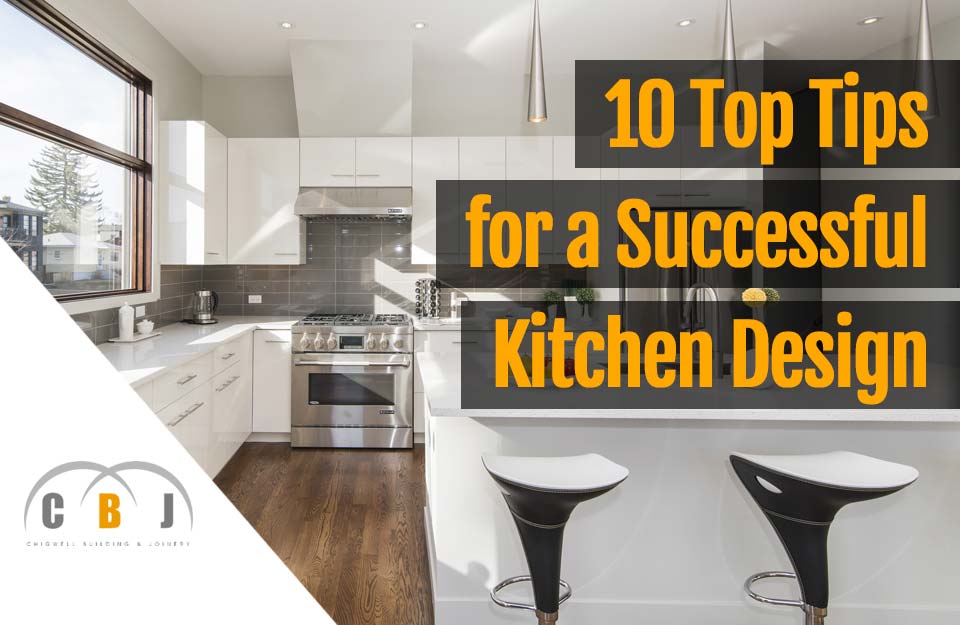
10 Top Tips for a Successful Kitchen Design
Author Chigwell Building & Joinery
Date 11/06/19
The kitchen is literally the hub of the home.
Therefore when you start to think of designing your new kitchen, you need to ensure you're going to make the right choices and decisions long term.
No one wants to be changing their kitchen every few years.
If you come to think of it, you and your family will be spending thousands of hours in the kitchen until you remodel or change it sometime in the future.
So it is imperative to choose well in terms of aesthetics as well as functionality.
Read on to discover our Top 10 Tips for a Successful Kitchen Design or jump to a chapter using the links listed below:
Chapters
- Proper Planning
- Efficient Layout
- The Kitchen Triangle
- Appliances & Power Sources
- Kitchen Cupboards & Storage
- Countertops
- Flooring
- Lighting
- Air
- Refuse
1. Proper Planning
The importance of planning ahead is crucial.
You cannot just go and pick the first kitchen that you like and have it installed.
You need to think through key aspects, such as the space available, your needs as a family, and practicality considerations.
A U-shaped kitchen might be the most common option as it offers various advantages, but it may not be the best choice for your room.
An L-shaped kitchen or a linear design might actually prove to be better in some cases.
You should make a list of the most important aspects and factors to consider so as to discuss them with the interior designer or kitchen manufacturer.
2. Efficient Layout
Your kitchen is where the family gathers for meals, but it is also where most family members meet up at other times of the day too.
You thus need to make sure that the kitchen design is kid-friendly, accessible and practical.
Wide walkways are recommended, especially near the cooking zone.
Ideally the cooktop should not be near high traffic areas as this could help in avoiding spills as well as increase safety since there is less chance for a handle to be caught or tipped.
The fridge on the other hand should not well accessible to all, including any passers-by.
3. The Kitchen Triangle
This is an extremely important aspect of kitchen design.
You will need to make sure that there is minimal space between the fridge, the sink and the cooker.
You cannot afford to move around from one to the other while they are located too far away from each other.
They should be placed in close proximity and in the layout of a triangle for maximum efficiency and practicality.
4. Appliances & Power Sources
When planning a kitchen you will need to devote some time thinking about the appliances which you plan to have, and where you will be placing them.
These decisions will allow you to plan the locations where you will need to have power sources to plug them in.
This includes gas and/or electricity lines.
As a general rule of thumb it is best to install multiple outlets along the kitchen backsplash.
Another useful tip with regards to kitchen appliances is to avoid placing appliances in corners as this could prove problematic for accessibility and practicality.
5. Kitchen Cupboards & Storage
Cabinets should be allowed enough door clearance. This also applies to appliance doors.
While corner cupboards may seem to be very spacious, generally they are not that practical as they are too deep and lack ease of accessibility.
Even if you have plenty of storage space you may end up in situations when you still do not have room to store everything.
From utensils and cookware, to kitchen supplies and dinnerware, you shall be storing a lot of items in your kitchen.
So you need to make it a point to plan your kitchen well so as to have plenty of space available.
- Overhead cabinets going right up to the ceiling could offer a welcome storage space for those kitchens where floor space is somewhat limited.
- Adding some shelves to combine storage and décor is another good idea. Here you can place certain key utensils, as well as spices, oils, and pots and pans which you tend to use often.
- At times drawers work out to be better than cupboards for certain items.
- While storage space is important, you need to make sure that there is enough space for all of the appliances, including small ones, which you might wish to have in your kitchen. These would otherwise end up cluttering the countertops and reducing space for other tasks.
6. Countertops
The surface area of the kitchen will be used as your worktop to prepare food, serve and do everything else!
Regardless of the amount of countertop space you will have, there may be times when it will not suffice.
Examples being when you have guests for dinner, or maybe when you have a party and there are more dishes and stuff lying here and there than there usually are.
You may thus wish to add more counter space by adding a kitchen island, if there is enough floor space.
Another important tip is to make sure that there are proper countertop spaces next to the cooktop, the microwave, and the fridge.
This is generally referred to as landing space that is the area where you will be placing items when using these appliances.
While discussing your kitchen countertops it also needs mentioning that the material you will be choosing is also important.
Make sure that the surface area is not only about aesthetics, but practicality.
Choose a material that is easy to care for and maintain.
Matte finishes do not look as dirty as glossy ones.
Also, avoid grouting or any material that could scratch easily.
7. Flooring
Slip resistant and easy to clean flooring options are recommended.
Remember that kitchens are prone to spills and stains.
So you need to choose wisely when you choose your kitchen flooring.
8. Lighting
The kitchen is a room that needs to be appropriately lit.
You should consider the most energy efficient type of lighting, as well as its positioning.
For instance, you do not want to have the lights placed in a way that they end up casting a shadow on your worktop rather than illuminating it properly.
Under cabinet lights are generally recommended.
9. Air
Bear in mind that your kitchen is a place where there is going to be a lot of moisture as well as odours.
You need to ensure that there is proper ventilation.
Should this be somewhat limited in terms of apertures make sure to invest in a good range hood.
10. Refuse
Easily overlooked, you need to allow space for trash disposal and recycling in your kitchen.
This is the place where most waste is generated.
Built-in bins may be the best option if it is possible to incorporate them.
Otherwise do make sure that there is enough space for garbage containers or bins.


